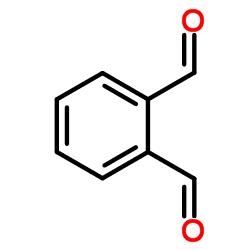o-Phthalaldehyde

o-Phthalaldehyde structure
|
Common Name | o-Phthalaldehyde | ||
|---|---|---|---|---|
| CAS Number | 643-79-8 | Molecular Weight | 134.132 | |
| Density | 1.2±0.1 g/cm3 | Boiling Point | 266.1±23.0 °C at 760 mmHg | |
| Molecular Formula | C8H6O2 | Melting Point | 55-58 °C(lit.) | |
| MSDS | Chinese USA | Flash Point | 98.5±19.6 °C | |
| Symbol |



GHS05, GHS06, GHS09 |
Signal Word | Danger | |
|
Glutamatergic receptor dysfunction in spinal cord contributes to the exaggerated exercise pressor reflex in heart failure.
Am. J. Physiol. Heart Circ. Physiol. 308(5) , H447-55, (2015) Excitatory amino acids (e.g., glutamate) released by contraction-activated skeletal muscle afferents into the dorsal horn of the spinal cord initiate the central component of the exercise pressor reflex (EPR) in physiological conditions. However, the role of ... |
|
|
Cardiovascular disease-related parameters and oxidative stress in SHROB rats, a model for metabolic syndrome.
PLoS ONE 9(8) , e104637, (2014) SHROB rats have been suggested as a model for metabolic syndrome (MetS) as a situation prior to the onset of CVD or type-2 diabetes, but information on descriptive biochemical parameters for this model is limited. Here, we extensively evaluate parameters rela... |
|
|
Unique Features of Human Protein Arginine Methyltransferase 9 (PRMT9) and Its Substrate RNA Splicing Factor SF3B2.
J. Biol. Chem. 290 , 16723-43, (2015) Human protein arginine methyltransferase (PRMT) 9 symmetrically dimethylates arginine residues on splicing factor SF3B2 (SAP145) and has been functionally linked to the regulation of alternative splicing of pre-mRNA. Site-directed mutagenesis studies on this ... |
|
|
Stable nanoparticles prepared by heating electrostatic complexes of whey protein isolate-dextran conjugate and chondroitin sulfate.
J. Agric. Food Chem. 63 , 4179-89, (2015) A simple and green method was developed for preparing the stable biopolymer nanoparticles with pH and salt resistance. The method involved the macromolecular crowding Maillard process and heat-induced gelation process. The conjugates of whey protein isolate (... |
|
|
Characterization of starter kimchi fermented with Leuconostoc kimchii GJ2 and its cholesterol-lowering effects in rats fed a high-fat and high-cholesterol diet.
J. Sci. Food Agric. 95 , 2750-6, (2015) The hypocholesterolemic effects of lactic acid bacteria and kimchi have been demonstrated previously. However, the kimchi fermentation process still relies on naturally present microorganisms. To obtain functional kimchi with consistent quality, we validated ... |
|
|
Organophosphate pesticides-induced changes in the redox status of rat tissues and protective effects of antioxidant vitamins.
Environ. Toxicol. 30(4) , 472-82, (2015) Organophosphates (OPs) pesticides are among the most toxic synthetic chemicals purposefully added in the environment. The common use of OP insecticides in public health and agriculture results in an environmental pollution and a number of acute and chronic po... |
|
|
Oxidative DNA damage induced by di-(2-ethylhexyl) phthalate in HEK-293 cell line.
Environ. Toxicol. Pharmacol. 39 , 1099-106, (2015) Di-(2-ethylhexyl) phthalate (DEHP) is commonly employed as a plasticizer. We have found that exposure of human embryonic kidney cell line 293 (HEK-293) to DEHP resulted in a crucial dose-dependent increase of DNA strand breaks in a comet assay. To elucidate t... |
|
|
New knowledge on the antiglycoxidative mechanism of chlorogenic acid.
Food Funct. 6 , 2081-90, (2015) The role of chlorogenic acid (CGA) in the formation of advanced glycation end-products (AGEs) (glycoxidation reaction) was studied. Model systems composed of bovine serum albumin (BSA) (1 mg mL(-1)) and methylglyoxal (5 mM) under mimicked physiological condit... |
|
|
Differential susceptibility of brain regions to tributyltin chloride toxicity.
Environ. Toxicol. 30 , 1393-405, (2015) Tributyltin (TBT), a well-known endocrine disruptor, is an omnipresent environmental pollutant and is explicitly used in many industrial applications. Previously we have shown its neurotoxic potential on cerebral cortex of male Wistar rats. As the effect of T... |
|
|
Glial GABA, synthesized by monoamine oxidase B, mediates tonic inhibition.
J. Physiol. 592(Pt 22) , 4951-68, (2014) GABA is the major inhibitory transmitter in the brain and is released not only from a subset of neurons but also from glia. Although neuronal GABA is well known to be synthesized by glutamic acid decarboxylase (GAD), the source of glial GABA is unknown. After... |